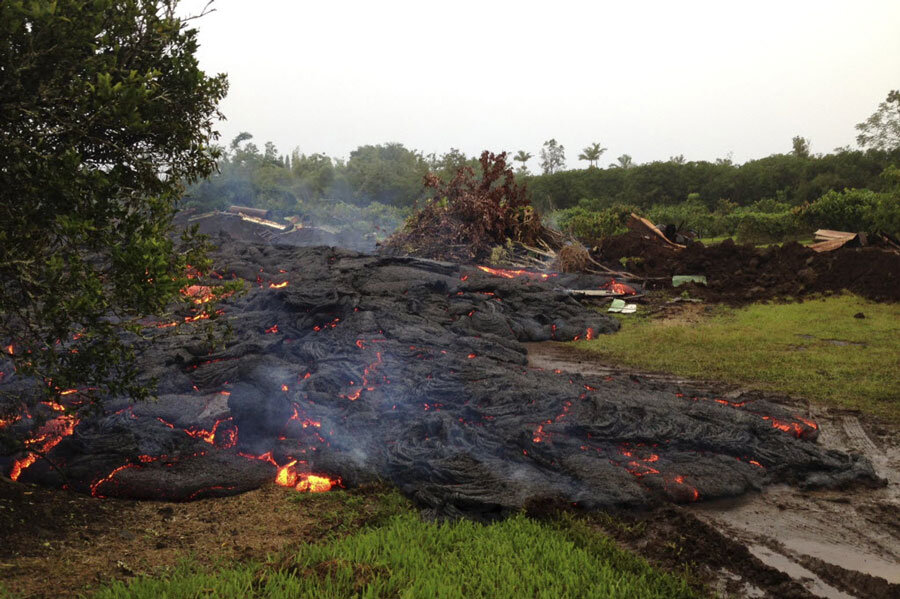Hawaii's slow-motion disaster: How does a community prepare for lava?
Loading...
| Los Angeles
As the world watches a slow-moving lava flow bear down on the rural Hawaiian community of Pahoa, questions inevitably arise about what can be done in the face of such an inexorable force.
The immediate answer for the roughly 900 or so residents of this remote region of Hawaii’s Big Island is, not much. Efforts have been made to protect utility poles from extreme heat as the flow passes by, for instance, but anything actually in the path of the 1,600-degree F. molten mass will incinerate upon contact, including any sort of barriers or channels constructed to steer the fiery mass.
Indeed, hazard risk management for volcanoes can be especially challenging, says Vincent Gawronski, associate professor of political science at Birmingham-Southern College in Alabama. Attempts to divert slow-moving lava – such as erecting barriers and channels, using cold water, and adding concrete – “have met with limited success,” he says via e-mail.
Unfortunately, “people have always been drawn to living near volcanoes because the soil is so fertile. It can be a deadly trade-off,” notes Professor Gawronski, who specializes in disaster preparedness and disaster response.
Perhaps the most famous episode of an attempt to control a lava flow occurred in Iceland in 1973. After an eruption on the island of Heimaey, residents evacuated. But the island has an important harbor, and it became clear that the flow was heading into the ocean with the potential to permanently block the harbor. Officials came up with the plan of blasting the wall of asphalt-like lava with cold seawater.
Ultimately, the progress of the lava stopped. But “there is a debate over whether the efforts had any effect because the eruption itself stopped,” says Benjamin Edwards, an associate professor of geology at Dickinson College in Carlisle, Pa.
Italians have had some success with creating channels and barriers that have directed low levels of lava flow, he notes. There have also been numerous attempts to interrupt the flow by dropping bombs. But, he says, most of them failed as the craters simply refilled with lava.
The Kilauea volcano in Hawaii began erupting in 1983. This current flow, moving anywhere from five to 30 yards an hour, began back in June. Residents were warned of possible evacuation orders beginning in September, and now, the flow has crossed into a residential area where dozens of homeowners have been told to leave. As of Wednesday, many have cleared their possessions, have taken photographs of their property for insurance purposes, and are being allowed to watch from a safe distance as their homes are consumed by the flow.
Andrew Schroeder, research and analytics director for the nonprofit group Direct Relief, argues that extreme physical events aren't disasters until they interact with populations. And the severity of disasters is determined as much by a population's ability to react and bounce back as by the disaster's magnitude, he says.
The 2010 earthquake in Haiti, typhoon Haiyan in the Philippines last year, and the current Ebola outbreak in West Africa are each a case in point. If these same events originated in a place with buildings designed to be resilient and a robust health infrastructure, the human toll would be far lower, he says.
“What is most challenging,” he notes, “is the decisions about when to invest today against a future unknown level of disaster tomorrow.”
For instance, several recent studies have outlined a disaster scenario for Hawaii in which the islands are devastated by a tsunami, he points out. “But that may never happen, or it could happen tomorrow. So how do you make the decision to spend on such a possibility while not investing in other needs?” he asks.
The tragic drama unfolding in Hawaii underlines a need to understand more about the science of volcanoes, says Professor Edwards, a volcanologist who specializes in volcanic eruptions, natural disasters, and the links between volcanoes and climate.
He hopes that such a visible event will provide a teachable moment – not just about volcanoes’ potential for disaster, but also about how they can be a resource. Among other things, “there is great potential for geothermal energy,” he says. “And it is a clean source of energy,” one that is already used in Iceland and New Zealand.





